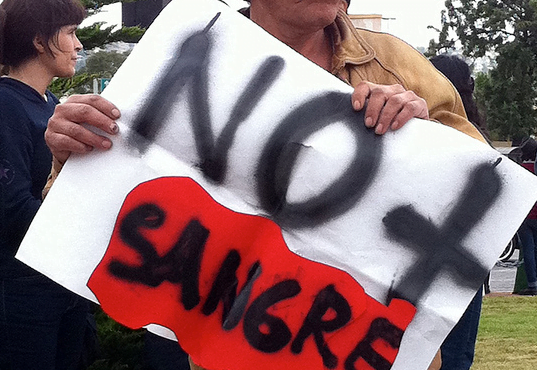Ed note. I am pleased to welcome Elizabeth Dickinson to UN Dispatch. Beth is a freelance journalist and former assistant managing editor at Foreign Policy magazine in Washington D.C. and Nigeria correspondent for The Economist, reporting from five continents. Check out her excellent new blog. –Mark
Mexico City, Mexico: Pick up the papers in Mexico these days and you’re likely to see something particularly alarming: among the daily toll of deaths and arrests in the country’s war on organized crime are an increasing number of children. Earlier this week, Mexican police pulled six combatants (two of them girls) under the age of 19 out of a firefight with the Zetas, one of the country’s largest organized crime cartels. In all, some 3,664 minors have been arrested in anti-crime operations since 2006.
The spectacular stories beg hard questions. Parts of Mexico are unmistakably at war, and what we know about conflict — particularly messy conflicts — is that somewhere along the chain children are always affected. On one side of the spectrum they are victims, caught up in the fighting themselves or witnesses to it. Or perhaps they are just prohibited from going out to play — or going to school. To the other extreme is the kind of child soldiering that plagues civil wars worldwide.
Mexico is seeing some degree of all of these troubles — so how bad is it?
Start with the victims. Between 2006 and 2010, the United Nations estimates that some 1,000 children have died in violence related to the ongoing conflict. That should be taken in context; the country already had one of the region’s higher adolescent mortality rates, at 1.4 deaths per 100,000, according to the country’s ministry health. Still, if 1,000 of the estimated 40,000 people who have died in the conflict are children, that’s certainly a significant percentage.
Equally troubling is the case of orphans — children who have lost one or more of their parents in the fighting. Edgar Cortez, an investigator on security issues at the Mexican Institute for Human Rights and Democracy, believes that there are between 10,000 and 15,000 children that fall into this category, he estimated in an interview this week. They are often absorbed into the same society in which they are orphaned — “sometimes they stay in the houses of relatives or of their neighbors,” he explained.
If not physical victims, children are also vulnerable to psychological damage, growing up traumatized by what they’ve seen — whether it’s direct violence, the fear that comes from living in an unstable community, or the inability to go outside, their parents fearful for their security. UNICEF in launching a pilot program in hopes of making inroads on exactly this: Over the coming months, they will train members of the security services on how to handle battle situations when children happen to be involved — be they raids on houses where children are present or hostage rescues where children are among the captives. If those situations are rightly managed when they happen, most children, it’s hoped, can avoid psychological consequences later.
But what if the children themselves get caught up in the very business of the drug war? What if they are recruited? This is certainly happening, argues the Network for the Right of the Child in Mexico – and it’s happening on a massive scale. Last January, the NGO estimated that 30,000 children were currently working in organized crime. They reported salaries of between $165 per month and $960 per month, depending on the region where the children were working.
Many dispute the statistic, arguing that, like so many aspects of this war, there simply isn’t enough data or investigation — in a word, knowledge — to put numbers on paper. But what’s clear is that children are popping up at the very least sporadically and perhaps systematically in places. They’re employed as lookout guards, informants, or even direct actors in the violence. It’s attractive particularly when there simply aren’t other options, “when children live in dilapidated conditions, where their prospects provide no real opportunities for a better life, there is no chance to get a good education,” explained Cortez.
The good news in all of this is that Mexico does pretty well when it comes to providing most of the services that should shelter kids as much as possible from all of this societal fracturing. The vast majority of children attend in school. Part of that good news followed from a now-famous program called Opportunidades, which offers cash grants to the poorest families on the condition that their kids are attending class.
Still, as in almost any country, that margin of children who aren’t in school is also the most vulnerable in conflict. Some 12.5 percent of children age 5 to 17 work in Mexico, according to the United Nations State of the World’s Children report, and of those, 42 percent doesn’t go to school. These are the same children who are most likely to be drawn — by economic necessity if nothing else — to the allure of the quick money of that organized crime offers.
So there is, in the very least, fertile ground for young recruitment — an alarming fact that even the most vivid stories of child combatants can convey. On top of the plethora of manifest reasons why it’s just plain awful news to have children involved in combat is the extent to which it embeds a conflict into a place. Once a generation has grown up and built their livelihoods around an illicit system, it’s a very difficult cycle to break. If that should happen in Mexico, the ongoing fighting will look simply like battles in a very, very long war.
